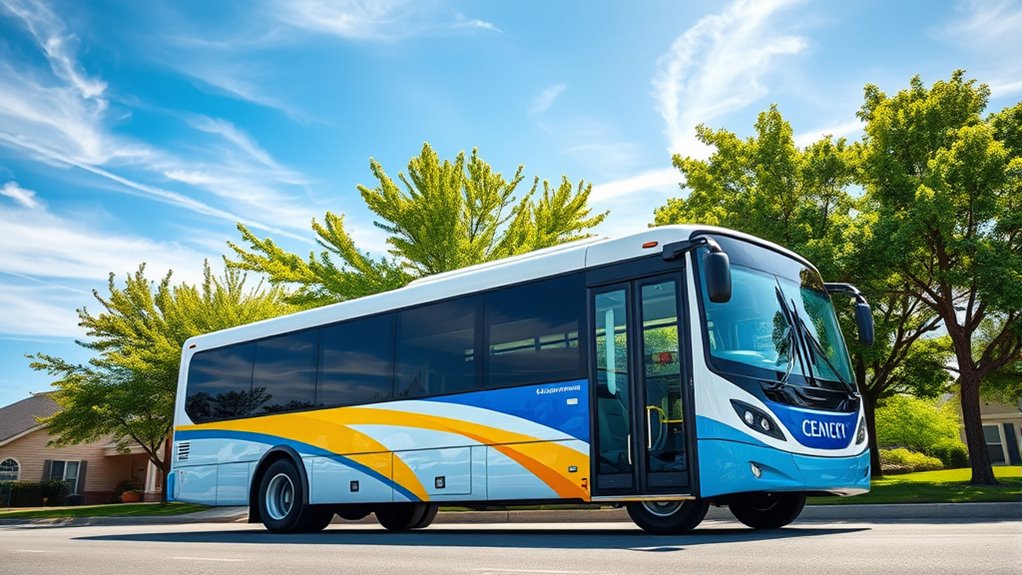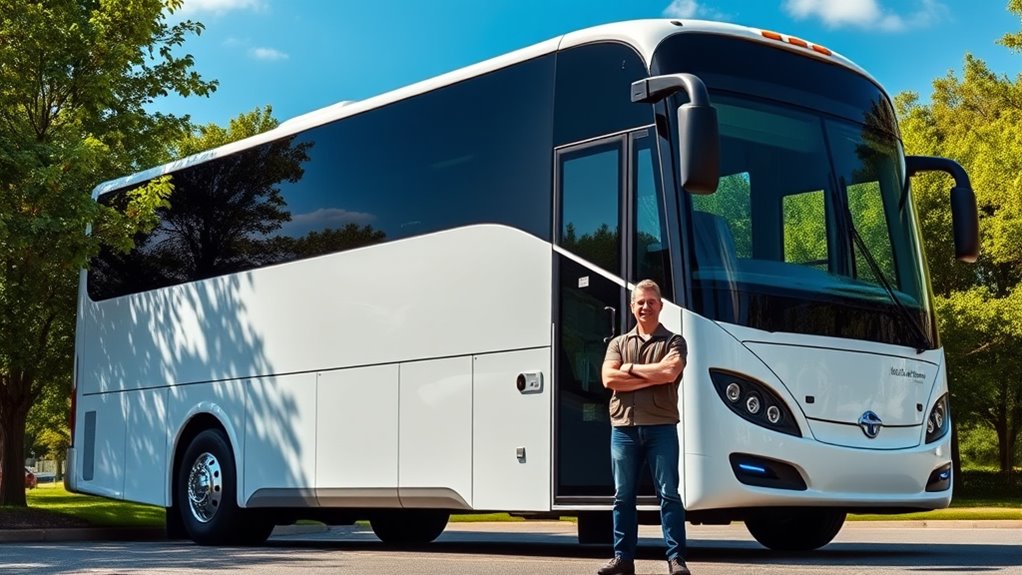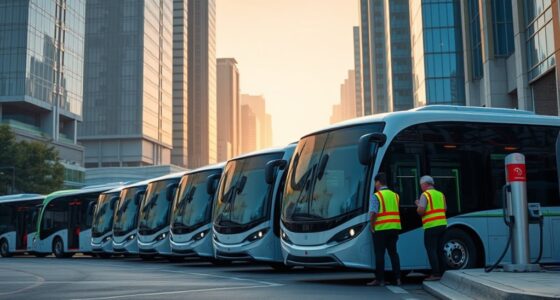Discover how a U.S. school bus driver achieved a remarkable 121 miles on a single charge by optimizing battery technology, practicing efficient driving techniques, and managing charging cycles carefully. This success highlights the importance of driver training and proper battery care in extending electric vehicle range. If you want to learn more about the strategies behind this record and what it means for sustainable transportation, keep exploring the inspiring details.
Key Takeaways
- The driver optimized driving habits, such as smooth acceleration and steady speeds, to maximize battery efficiency.
- Advances in battery technology increased energy capacity, enabling the bus to travel longer distances per charge.
- Proper battery management practices, including avoiding overcharging, helped preserve battery health and extend range.
- Effective driver training focused on energy-conserving techniques, contributing to the record 121-mile achievement.
- The milestone demonstrates the growing viability of electric buses for longer school routes and sustainable transportation.

A U.S. school bus driver has set a new record by driving an electric bus for 121 miles on a single charge, showcasing the potential of electric vehicles in daily transportation. This achievement highlights how advancements in battery technology are making electric buses more viable for long routes, reducing reliance on fossil fuels, and lowering emissions. As you consider the future of school transportation, understanding the importance of the battery’s capacity and performance becomes clear. Modern batteries now store more energy, allowing buses to cover greater distances without frequent recharging. This progress means drivers like you can confidently operate electric buses on longer routes, knowing that the vehicle’s range will meet daily demands. However, leveraging this technology effectively requires proper driver training. You need to learn how to optimize driving habits—such as smooth acceleration, maintaining steady speeds, and minimizing unnecessary braking—to extend the bus’s range. Training programs emphasize these techniques, helping you become more efficient and ensuring the battery lasts throughout the day. By mastering these skills, you not only improve the bus’s performance but also contribute to energy conservation and cost savings for your school district. Battery technology isn’t just about the capacity; it also involves understanding how to manage charging cycles and prevent battery degradation. During your training, you’ll learn best practices for charging, such as avoiding overcharging or deep discharges, which can harm the battery’s longevity. This knowledge allows you to plan routes and charging schedules better, making sure the bus is ready for each day’s work without unexpected interruptions. Additionally, high refresh rates in projectors can enhance the clarity of visuals displayed during driver training sessions, making instructional content more engaging and easier to understand. The combination of advanced battery tech and thorough driver training creates a synergy that makes electric buses more practical and appealing. As you become more familiar with the vehicle’s capabilities, you’ll feel confident in pushing its limits while safeguarding its lifespan. Your role is vital in the switch to sustainable transportation, and mastering both the technical aspects of the batteries and the driving techniques ensures you’re part of this positive change. The record-setting 121 miles demonstrates that with the right technology and proper training, electric buses can meet the demands of daily school transport. This progress encourages more districts to adopt electric vehicles, knowing that their drivers are equipped to maximize efficiency. Ultimately, your expertise and comfort with the latest battery technology make you a key player in revolutionizing school transportation, proving that sustainability and practicality go hand in hand on the road.
Frequently Asked Questions
What Specific Modifications Were Made to Achieve This Range?
You optimize the battery by upgrading to high-capacity cells and managing thermal conditions effectively. Additionally, you improve the charging infrastructure by installing fast chargers and ensuring consistent access to power sources. These modifications work together, enhancing battery performance and allowing you to cover 121 miles per charge. The focus on battery optimization and reliable charging infrastructure makes this impressive range achievable for your electric school bus.
How Does Weather Impact the Bus’s Charging Performance?
Like a delicate plant needing the right conditions to thrive, your bus’s battery performance is affected by weather variability. Cold temperatures slow chemical reactions in the battery, reducing range and efficiency, while hot weather can cause overheating. On a chilly morning, you might notice the bus’s range drops, making it essential to plan charging around weather conditions. Keeping batteries warm or cool helps maintain peak performance.
What Are the Maintenance Requirements for the Electric Bus?
You need to regularly check the battery’s health to guarantee ideal battery longevity. Keep the charging infrastructure well-maintained, including inspecting chargers and cables for damage. Schedule routine inspections for the electrical system, brakes, and tires. Proper maintenance helps extend the bus’s lifespan, ensures safety, and maximizes performance. By staying proactive, you’ll keep the electric bus operating efficiently and reliably, reducing downtime and costly repairs.
How Does the Cost Compare to Traditional Diesel Buses?
You’ll find that electric buses cost more upfront but save you money long-term thanks to lower fuel and maintenance costs. Thanks to electric vehicle incentives, the initial price drops, making them more appealing. Plus, battery recycling helps offset environmental costs. When comparing, remember that diesel buses have higher fuel and repair expenses, so investing in electric buses can be a smarter, more sustainable choice—even if the sticker shock is real at first.
Are There Plans to Replicate This Success in Other Districts?
Yes, there are plans to replicate this success in other districts. You’ll see increased district collaboration and explore funding opportunities to support electric bus adoption. These initiatives aim to share best practices, secure grants, and pool resources, making it easier for more districts to implement electric buses like the Charging Queen’s. This coordinated effort helps expand sustainable transportation options, reducing costs and environmental impact across schools nationwide.
Conclusion
You’ve just witnessed how one determined school bus driver defies expectations, pushing an electric vehicle to an astonishing 121 miles per charge. This isn’t just a record; it’s a revolution, proving that electric buses can go further than anyone thought possible. Imagine what you could accomplish with that kind of power—this achievement isn’t just a milestone, it’s a beacon guiding us toward a cleaner, greener future where limits are shattered like glass.









